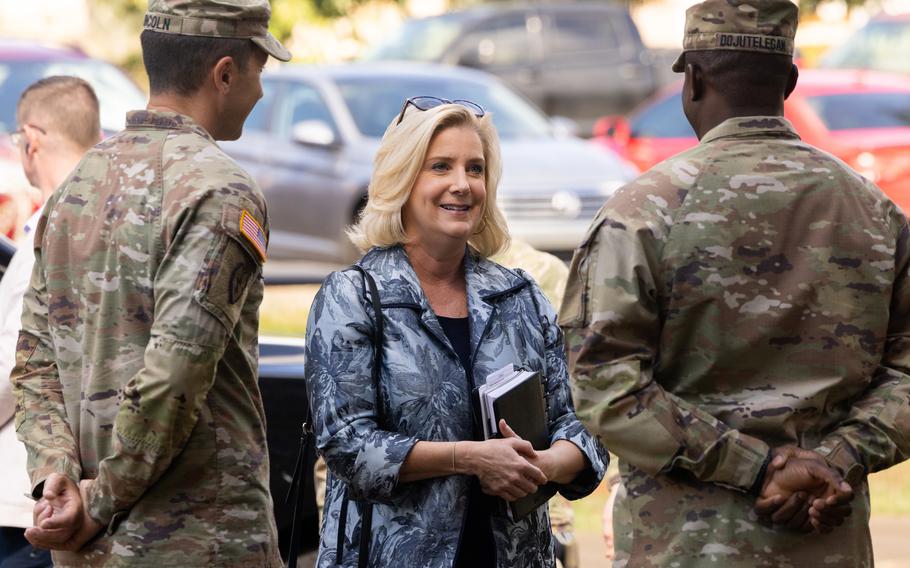
Army Secretary Christine Wormuth speaks with soldiers from the 25th Infantry Division before having lunch with them and other U.S. Army Garrison Hawaii soldiers at the Sustainment Bistro on Schofield Barracks, Hawaii, on Jan. 24, 2023. (Rachel Christensen/U.S. Army)
WASHINGTON — Army Secretary Christine Wormuth said Thursday that solving the service’s recruiting problem is her top priority, but the struggle to find new troops could last into 2024, or longer.
“The number one priority, in my mind, for this year … is fixing our recruiting problem,” she said during a discussion hosted by the Project for Media and National Security at George Washington University. “The Army missed its recruiting target last year by about 15,000 people. That is a very serious situation for us.”
The Army sought 60,000 new recruits in 2022 but enlisted only 45,000. For 2023, the service is aiming even higher — for 65,000 new members.
“We really have to get after our recruiting challenge,” Wormuth told reporters at the event. “This is, frankly, a challenge not just for the United States Army but for all of the services.”
Fewer than 25% of all young Americans between the ages of 17 and 24 qualify academically and physically to serve in the military, according to recent Pentagon data. Many of them can’t pass the Armed Services Vocational Aptitude Battery, a test that measures potential recruits’ aptitude and fitness to serve.
Officials in all the services have said it’s more difficult to attract new members in the modern landscape due to several factors, such as childhood obesity and an “awareness gap,” or a lack of understanding among young people about military life and its benefits.
“I’ve talked with thousands of young adults across the nation. I’ve noticed some awareness questions that really caught me off guard, like ‘Hey, I was told that until I finish basic training and Advanced Individual Training, I can’t get paid,’ or ‘[I can’t] own a pet as a soldier,’ ” said Maj. Gen. Johnny Davis, commanding general of Army Recruiting Command. “And certainly, all of these things are not true. We’re really bringing that awareness to this future market.”
The Army has begun offering new incentives to boost recruiting, such as offering promotions for referral signups, a new recruiting ribbon, financial bonuses and letting recruits choose their station when they finish basic training.
However, the Army has said it won’t lower admissions standards to bring in more recruits, so solving the problem is expected to take time.
“It took us more than a year to get into the situation that we’re in, in terms of the recruiting landscape, and I think it’s going to take more than a year to turn it around,” Wormuth said. “We are in the process of reintroducing the Army to the American public.”
The secretary called the Army’s goal of 65,000 recruits for 2023 “very ambitious.”
“We are pulling out all of the stops,” she added.
Gen. James McConville, the Army’s chief of staff, said the service is undergoing the “biggest transformation in 40 years” with its new recruiting efforts, new doctrines, new organizations and new ways of training soldiers. Sgt. Maj. of the Army Michael Grinston also stressed the importance of retaining soldiers, not just recruiting them.
“Once people go in the Army, they want to stay,” Grinston said, noting new members eventually are retained and promoted. Retention, he said, will help the Army avoid a shortage of noncommissioned officers in a few years.
Last year, the Army was short about 20,000 soldiers from its desired force size of 485,000 troops, and officials have cautioned repeated failures to meet personnel targets could have a cascading effect on U.S. capabilities and readiness worldwide.
“We have got 100,000 service members in Europe right now working to either support Ukraine, help train the Ukrainians or standing shoulder-to-shoulder with our NATO allies. And about 50,000 of those service members are Army service members,” Wormuth said.
On Ukraine, she gave an update on the Army’s mission to procure dozens of new M1 Abrams tanks and send them to Ukrainian troops. The Pentagon and President Joe Biden agreed last month to send Ukraine a version of the Abrams M1A2, but it will take time because they must be built — a process that takes months. The Pentagon has not yet given a firm timeline on when Ukraine might start getting them.
“It’s not going to be a matter of weeks, I can tell you that,” Wormuth said. “There are longer timelines involved. But I think there are options that are less than two years, less than a year and a half.”
She said it is possible Ukraine could begin receiving the first Abrams tanks before the end of 2023.